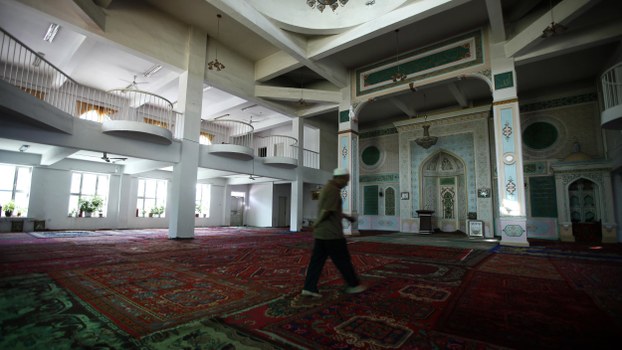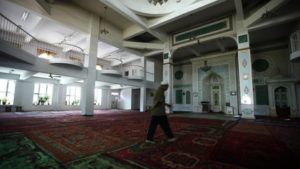Uyghurs Ordered to Destroy Muslim Architecture Deemed ‘Extremist’ by Authorities

Radio Free Asia, 10 July 2019
 By Shohret Hoshur –Authorities in northwest China’s Xinjiang Uyghur Autonomous Region (XUAR) are forcing Uyghurs and other Muslim minorities to destroy traditional architectural features used for prayer in their homes as part of a bid to root out “religious extremism,” according to sources.RFA’s Uyghur Service recently received information suggesting that villagers in Ghulja (in Chinese, Yining) county, in the XUAR’s Ili Kazakh (Yili Hasake) Autonomous Prefecture, have been forced to remove Muslim ornamentation from buildings in the area, while a video currently circulating on social media purports to show a Uyghur woman using a shovel to tear down a “mihrab” from her ceiling.
By Shohret Hoshur –Authorities in northwest China’s Xinjiang Uyghur Autonomous Region (XUAR) are forcing Uyghurs and other Muslim minorities to destroy traditional architectural features used for prayer in their homes as part of a bid to root out “religious extremism,” according to sources.RFA’s Uyghur Service recently received information suggesting that villagers in Ghulja (in Chinese, Yining) county, in the XUAR’s Ili Kazakh (Yili Hasake) Autonomous Prefecture, have been forced to remove Muslim ornamentation from buildings in the area, while a video currently circulating on social media purports to show a Uyghur woman using a shovel to tear down a “mihrab” from her ceiling.
Islamic architecture traditionally includes mihrabs, or ornate domed niches built into a wall or ceiling, to denote the correct direction one should face when praying to Mecca.
After contacting sources in various parts of the XUAR to determine how widespread the directive is, officials in Kashgar (Kashi) and Hotan (Hetian) prefectures told RFA that Muslims are being made to carve out the domed shape of mihrabs, or to fill them in completely, lest they face punishment that could include detention in an internment camp.
Authorities are believed to have detained up to 1.5 million Uyghurs and other Muslim minorities accused of harboring “strong religious views” and “politically incorrect” ideas in the XUAR’s vast network of camps since April 2017.
The director of a neighbourhood women’s committee in Kashgar city told RFA on condition of anonymity that “the government and [China’s ruling Communist Party] have implemented training courses [on the correct aesthetics] for households.”
When asked whether anyone in the city still has a mihrab in their home, the director said authorities “have corrected everything and no such thing exists now.”
A village party secretary in Hotan prefecture, who also declined to give his name, said that around a year ago, his local Household Committee instructed him to “remove any structures that have the shape of a mihrab” from his home.
“I had the [arch atop the] mihrab carved in the wall reshaped into a square, as ordered,” he said.
“Basically, all the owners of homes containing decorations deemed to be a sign of religious extremism have been ordered to remove them or reconstruct the building by the Household Committee, and all of the homes have to pass re-inspection.”
The party secretary said that teams of five or six people that include police officers, cadres, and government officials “walk around inspecting neighborhood homes” to ensure they meet “requirements.”
In cases where homeowners are unable to reshape the mihrabs in their walls, or where mihrabs were carved into a home’s supporting beams, workers are sent in to demolish the building.
“In Hotan city, all of the buildings have been cleared of these items completely … even those built by rich people,” he said.
“At present, no buildings considered to exemplify classic ethnic characteristics have been left untouched.”
Camp system
Since XUAR party chief Chen Quanguo was appointed to the region in August 2016 and initiated harsh policies depriving the fundamental rights and freedoms of Uyghurs and other Muslim minorities guaranteed by China’s constitution and regional ethnic autonomy laws, many have been sent to internment camps for infractions such as “growing beards, praying, or even owning a prayer rug or Quran [Islamic holy book] in their homes,” sources say.
Though Beijing initially denied the existence of the camps, China has tried to change the discussion, describing the facilities as “boarding schools” that provide vocational training for Uyghurs, discourage radicalization and help protect the country from terrorism.
Reporting by RFA’s Uyghur Service and other media organizations, however, has shown that those in the camps are detained against their will and subjected to political indoctrination, routinely face rough treatment at the hands of their overseers, and endure poor diets and unhygienic conditions in the often overcrowded facilities.
In May, U.S. Secretary of State Mike Pompeo, in an apparent reference to the policies of Hitler’s Germany and Stalin’s Soviet Union, cited “massive human rights violations in Xinjiang where over a million people are being held in a humanitarian crisis that is on the scale of what took place in the 1930s.”
U.S. Ambassador-at-Large for International Religious Freedom Sam Brownback recently told RFA in an interview that countries around the world must speak out on the Uyghur camps, or risk emboldening China and other authoritarian regimes.
The U.S. Congress has also joined in efforts to halt the incarcerations, debating legislation that seeks accountability for China’s harsh crackdown on the Uyghurs. The Uyghur Human Rights Policy Act would appoint a special State Department coordinator on Xinjiang and require regular reports on the camps, the surveillance network, and the security threats posed by the crackdown.
Reported by Shohret Hoshur for RFA’s Uyghur Service. Translated by RFA’s Uyghur Service. Written in English by Joshua Lipes.
https://www.rfa.org/english/news/uyghur/architecture-07102019140830.html

